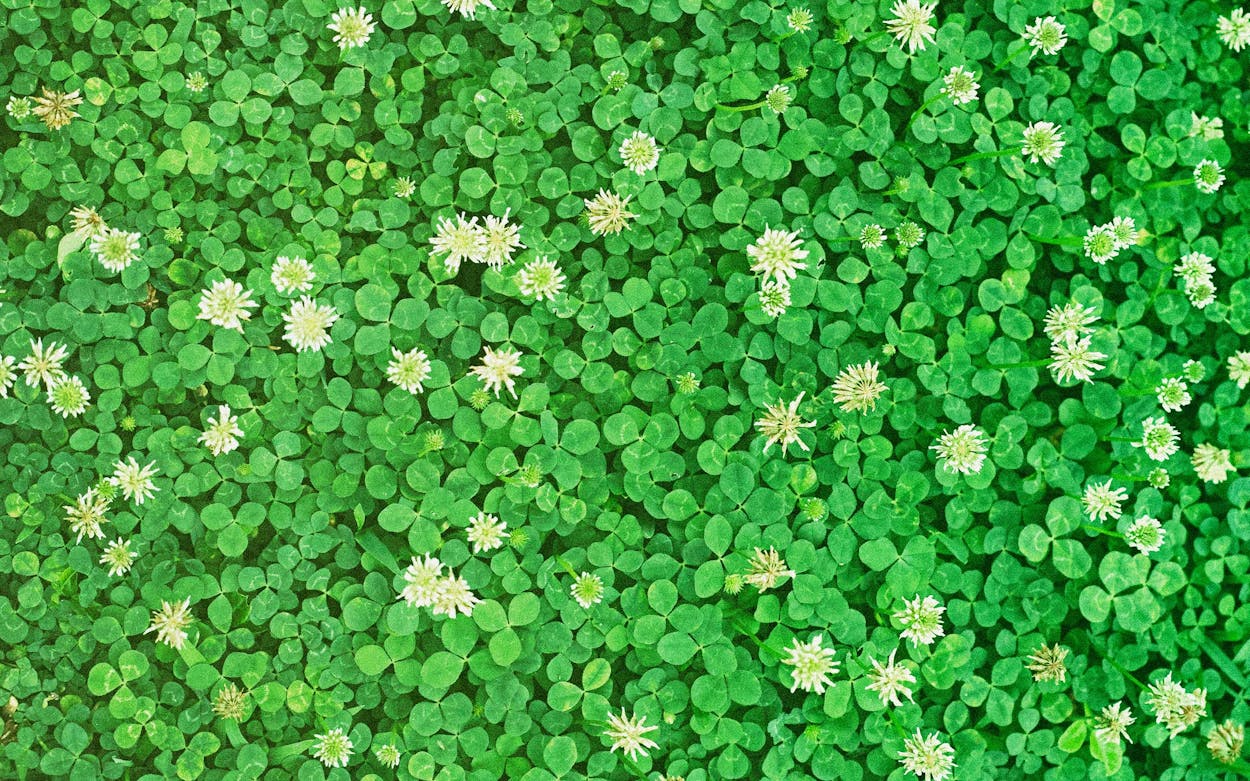Trends in gardening and yard care don’t fluctuate as frequently as other cultural phenomena. Maybe that’s why more and more people seem to be taking notice of the current antilawn movement rippling through the U.S. With the lawn predicted to be “Gen Z’s next victim,” more people seem to be asking if grass (with all the watering and weeding it requires) is really always greener. And now there’s a new wave of yard-care enthusiasts who will tell you it really doesn’t get much greener than clover.
Most recently popularized by TikTok users chronicling their traditional yards’ transitions to clover wonderlands, clover lawns are extremely in. Or maybe it’s just that grass—after a summer that saw record-setting temperatures across the country, widespread drought, and insistent global warming—is extremely, belatedly out.
Clover-lawn converts say they mow less frequently, water less often, and are more likely to feel like they’re traipsing through the English countryside in the early nineteenth century than their grass-lawn counterparts. There’s a whimsy to the friendly clover leaves that makes traditional blades of grass look nearly tryhard. Broad and low-lying, clover spreads effortlessly over the ground once introduced. It’s why searching for “clover lawns” online still brings up a fair amount of advice on how to keep the plant from taking over sacred grass spaces.
Clover is easy, and it comes with a tidy list of both environmental and personal benefits. Its roots release nitrogen, a nutrient crucial for healthy soil, back into the ground. You’ll be attracting honeybees (so cute). You’ll save money on the chemicals and pesticides you were using to fight back plants that threaten grass, and on general lawn care. Clover also holds up better against foot traffic, doesn’t brown when your dog pees on it, and, as many note online, looks like fairies might secretly reside among its leaves.
Depending on the variety, clover is also fairly hardy. White clover, the variety clover-lawn advocates often champion, is aptly named for the small, white flowers it sprouts during spring. Also called Dutch clover, the variety is best grown in the U.S. Department of Agriculture’s plant hardiness zones four through nine. Texas ranges between zones six through ten, but it’s good to note that the data determining the zones has notoriously not been updated since 2012. Clover really does sound like the real deal: the solution to lawns in Texas and beyond.
But from talking to Andrea DeLong-Amaya, the director of horticulture at Austin’s Lady Bird Johnson Wildflower Center, clover is absolutely not the answer. Well, it can be, but not in every yard, and that’s the whole point.
Like many horticulturists, DeLong-Amaya is excited by the antigrass movement. But she’s also wary of the rapid fandom clover lawns have inspired, saying it echoes the trend of manicured-grass lawns and embodies, in a different form, the true environmental enemy: monoculture lawns. While traditional grass yards are the most popular examples, monoculture lawns are any lawns where a single type of plant is cultivated exclusively.
“I think it’s better ecologically and more interesting to have a garden full of native plants. That’s my whole deal,” DeLong-Amaya said. “If you have a grass lawn and start seeing clover coming in, I think the message is to tolerate those. A lot of the message is to tolerate—getting away from needing to have a perfect lawn. It’s healthier to have something that’s more mixed and blended, with a diversity of species.”
While DeLong-Amaya says there are some species of clover that are native to Texas, the ones clover-lawn enthusiasts most frequently reference (including white clover) are species that originated in Europe and Asia. Hence why honeybees, which are also European, are some of clover’s biggest pollinators.
DeLong-Amaya doesn’t deny the long list of benefits clover-lawn supporters trumpet. “It’s better than a lawn,” she says, “and much better than a grass monoculture lawn, but if you really want to serve our native fauna, using native plants will always be more effective for that.” A lawn with a variety of native plants will also compound many of the benefits a clover lawn yields. Texas bluebonnets, like clover, belong to the legume family, and thus also help enrich the soil where they are planted. DeLong-Amaya also suggests Texans looking to diversify their lawns try scarlet pea, frogfruit, or ruellias. All of these plants create a hearty and appealing ground cover, flower annually, and are native to many Texas regions.
If you’re reading this from El Paso, or any of the drier, hotter parts of the state, DeLong-Amaya says a clover lawn might not be an option at all. “They’re going to want richer and deeper soil,” she said. “Each region has its own palette of native species that would be appropriate.” DeLong-Amaya suggests curious gardeners utilize the plant search on the Wildflower Center’s website, which matches the plants best suited to your region based on a number of factors.
Even Texas’s traditionally wetter regions would have likely fried a clover lawn during the streaks of sunny, triple-digit-temperature days they experienced this summer. “It’s a cool-season plant,” DeLong-Amaya said. “You’d want to have something else that would grow in the summertime that would tolerate the heat. I don’t recommend a clover lawn. If you have it in your lawn, I’d say leave it, but I wouldn’t make an effort to plant it. If you have just clover, you’re going to have a bunch of dead stuff in the summertime.”
Regardless, DeLong-Amaya is encouraged by the shift. “A lot of people still really feel like a perfect lawn is the way to go and that is the goal of beauty. But I think a lot of it is just retraining our brains to just appreciate something else and see the beauty in what’s there.”






